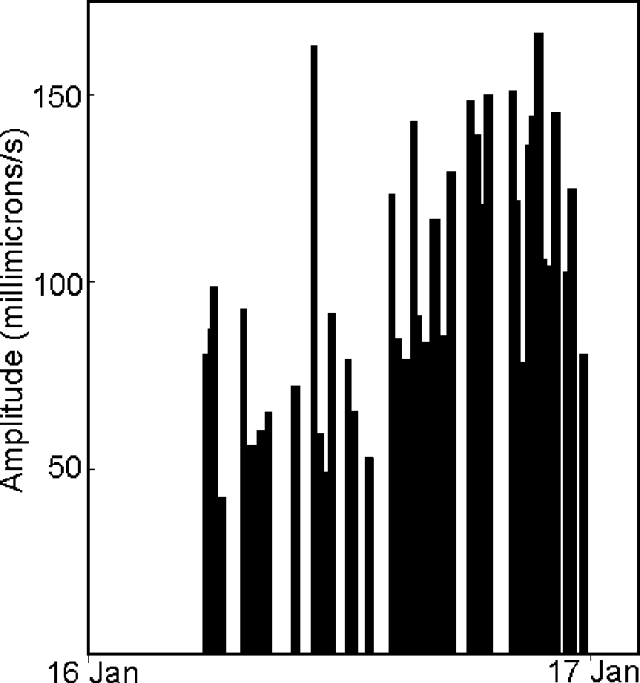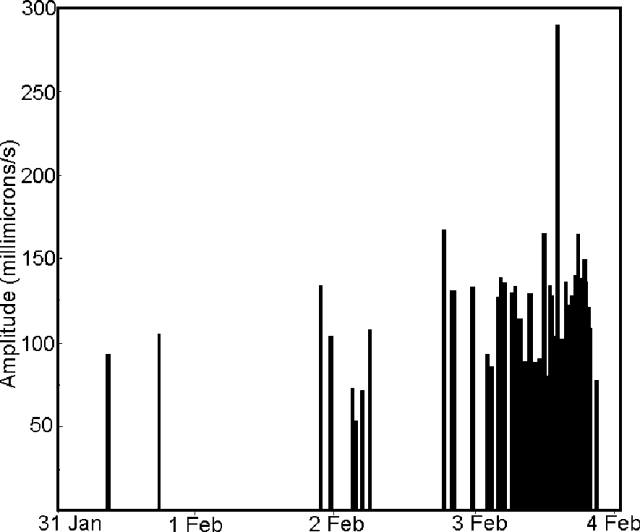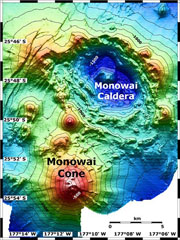Report on Monowai (New Zealand) — January 1998
Bulletin of the Global Volcanism Network, vol. 23, no. 1 (January 1998)
Managing Editor: Richard Wunderman.
Monowai (New Zealand) Acoustic signals from submarine explosions detected
Please cite this report as:
Global Volcanism Program, 1998. Report on Monowai (New Zealand) (Wunderman, R., ed.). Bulletin of the Global Volcanism Network, 23:1. Smithsonian Institution. https://doi.org/10.5479/si.GVP.BGVN199801-242050
Monowai
New Zealand
25.887°S, 177.188°W; summit elev. -132 m
All times are local (unless otherwise noted)
The French Polynesian Seismic Network detected short episodes of acoustic signals from the Kermadec area during both 16-17 January and 31 January-3 February. According to the signal arrival times at various stations, the source was Monowai Seamount. The two events were interpreted as later stages of the eruptive activity of 15-17 December 1997 (BGVN 22:11).
The first episode, which lasted from 1739 on 16 January until 1034 the next day (figure 5), included weak, long, high-frequency tremors. At 0200 on 17 January, the tremors increased in intensity and short explosive waves appeared. The total number of acoustic waves recorded during the event was 69; nine of the waves during the first two hours were interpreted as explosive. The strongest wave, recorded at 0927 on 17 January, was not explosive.
 |
Figure 5. Acoustic waves from Monowai Seamount during 16-17 January (times are GMT). Courtesy of O. Hyvernaud. |
The second episode of acoustic activity consisted of 86 waves during 31 January-4 February (figure 6). Explosive waves accounted for 18 of the total. The strongest, at 0250 on 4 February, was not explosive. The main activity was concentrated on 3 February but stopped suddenly.
 |
Figure 6. Acoustic signals from Monowai Seamount during 31 January-4 February (times are GMT). Courtesy of O. Hyvernaud. |
Monowai Seamount, also known as Orion seamount, lies midway between the Kermadec and Tonga Islands, ~1,400 km NE of New Zealand. Small parasitic cones occur on its N and W flanks. Numerous eruptions have been detected from submarine acoustic signals since 1977. Surface observations have included water discoloration, vigorous gas bubbling, and areas of upwelling water accompanied by rumbling noises.
Geological Summary. Monowai, also known as Orion seamount, is a basaltic stratovolcano that rises from a depth of about 1,500 to within 100 m of the ocean surface about halfway between the Kermadec and Tonga island groups, at the southern end of the Tonga Ridge. Small cones occur on the N and W flanks, and an 8.5 x 11 km submarine caldera with a depth of more than 1,500 m lies to the NNE. Numerous eruptions have been identified using submarine acoustic signals since it was first recognized as a volcano in 1977. A shoal that had been reported in 1944 may have been a pumice raft or water disturbance due to degassing. Surface observations have included water discoloration, vigorous gas bubbling, and areas of upwelling water, sometimes accompanied by rumbling noises. It was named for one of the New Zealand Navy bathymetric survey ships that documented its morphology.
Information Contacts: Olivier Hyvernaud, BP 640, Laboratoire de Geophysique, Papeete, Tahiti, French Polynesia.

